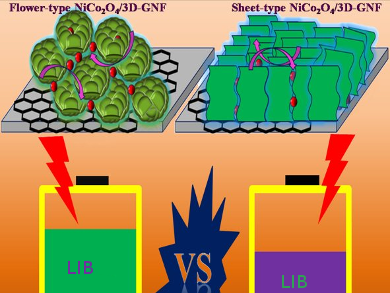Lithium-ion batteries (LIBs) are amongst the most effective and practical batteries for portable electronic devices owing to their flexibility, high energy density, and long lifespan. In the search for even more efficient and high performance batteries, a great deal of effort has been placed on the search for improved materials for LIB electrodes. For traditional electrode preparation, the active materials are usually mixed with binders and conductive agents; unfortunately this often leads to a loss in energy capacity. Therefore, the search for binder-free electrodes is of great interest.
Jong-Sung Yu and his group at the Daegu Gyeongbuk Institute of Science and Technology, Republic of Korea, have managed to produce nanostructured NiCo2O4 materials directly grown on the surface of three-dimensional graphene-coated nickel foam by a facile electrodeposition technique and subsequent annealing. The morphology of the NiCo2O4, flower- or sheet-type, can be tuned by variation of the potential or current during electrodeposition.
The flower-type material showed a high reversible discharge capacity (1459 mAh g–1 at 200 mA g–1) and excellent cyclability. The researchers attributed this good performance to high volume utilization efficiency, a well-preserved connection between the active materials and the current collector, a short lithium-ion diffusion path, and fast electrolyte transfer in the binder-free NiCo2O4-coated 3D graphene structure.
- Morphology-Tuned Synthesis of NiCo2O4-Coated 3D Graphene Architectures Used as Binder-Free Electrodes for Lithium-Ion Batteries,
Chunfei Zhang, Jong-Sung Yu,
Chem. Europ. J. 2016.
DOI: 10.1002/chem.201504386




